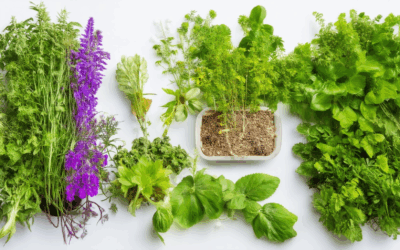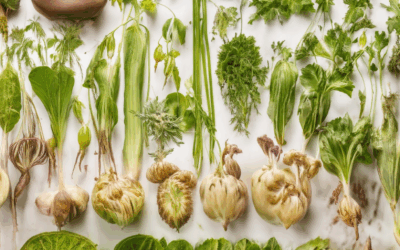Organic herb cultivation has gained significant popularity among gardening enthusiasts looking to embrace eco-friendly practices and enjoy fresh, natural herbs year-round. For many, the idea of growing their own organic herbs seems daunting, but with the right approach, it becomes a rewarding experience that promotes sustainability and health. Whether you’re a seasoned gardener or new to the world of plant care, this guide offers comprehensive insights into starting your organic herb cultivation journey. From selecting the perfect herbs to preparing your growing space and maintaining healthy plants, we’ll walk you through everything you need to know to succeed. Additionally, we’ll explore creative ways to use your harvested herbs and address common challenges, ensuring your organic garden thrives. By adopting organic methods, you not only enhance the quality of your produce but also contribute to a healthier planet. So, let’s dive into the essential tips, methods, and strategies that will help you master organic herb cultivation.
Key Takeaways
– Choose the Right Herbs: Opt for climate-suited herbs like basil, rosemary, thyme, and parsley.
– Maximize Sunlight Exposure: Select a sunny spot for optimal growth.
– Prepare Well-Draining Soil: Enrich with compost or aged manure for fertility.
– Water Consistently but Avoid Overwatering: Use drip irrigation or a watering can.
– Practice Companion Planting: Enhance growth and deter pests with compatible herbs.
– Monitor for Pests and Diseases: Use natural remedies like neem oil for treatment.
– Harvest at Peak Flavor: Clip stems when flowers develop for best taste.
How to Start Organic Herb Cultivation for Beginners
Organic herb cultivation is a rewarding journey that allows you to grow your own fresh herbs naturally. Here’s a step-by-step guide to help you get started:
Step 1: Choose the Right Herbs
Select herbs that are well-suited to your growing conditions. Some popular options for beginners include:
- Basil
- Rosemary
- Thyme
- Mint
- Cilantro
- Oregano
Step 2: Prepare Your Growing Space
Find a location that receives plenty of sunlight, ideally 6-8 hours per day. Herbs thrive in well-drained soil. You can use container gardens, raised beds, or even window boxes depending on your space and preferences.
Step 3: Plant the Herbs
Start with young plants or seeds. For faster results, opt for starter plants. Make sure to water them regularly but avoid overwatering, as herbs prefer well-drained soil.
Step 4: Maintain Proper Care
Regular maintenance is crucial for healthy growth. Apply compost or liquid fertilizer every few weeks during the growing season. This helps provide essential nutrients and promote strong growth.
Step 5: Protect from Pests
Herb gardens often face issues like aphids and spider mites. To maintain an organic garden, consider using natural pest control methods such as ladybugs or neem oil solutions.
Step 6: Harvest Your Herbs
Harvest herbs when they reach their peak flavor. For some herbs like basil and cilantro, regular pruning encourages continuous growth. Store fresh herbs in the refrigerator or dry them for year-round use.
Step 7: Plan for Seasonality
Understand the growing seasons for your region. Many herbs thrive in warmer climates, while others perform better in cooler temperatures. Plan your planting schedule accordingly to maximize your harvest.
Step 8: Enhance Growth with Mulch
Apply mulch around your plants to retain moisture, suppress weeds, and regulate soil temperature. This simple practice can significantly improve plant health and yield.
By following these steps, you can create a thriving organic herb garden that provides fresh, nutritious herbs for your cooking. Happy gardening!
For more tips and resources on heirloom gardening and sustainable practices, visit Old Seed .
Easy Organic Herb Cultivation Tips for Beginners
Starting with organic herb cultivation can be a rewarding experience. Here are some simple tips to help you grow your own herbs successfully:
- Choose the Right Location: Select a sunny spot in your garden or windowsill. Most herbs thrive in full sunlight, though some varieties prefer partial shade.
- Water Gently: Herbs require consistent moisture but don’t like sitting in wet soil. Water deeply once or twice a week, depending on rainfall and temperature.
- Add Compost: Incorporate compost or aged manure into the soil to improve fertility and promote healthy growth. This helps prevent pests and diseases.
- Start Small: Begin with a few herbs like basil, thyme, or parsley. These are relatively easy to grow and great for beginners.
- Seasonal Planting: Many herbs are seasonal, so choose varieties that work well in your climate. For example, cool-season herbs like spinach and kale can be planted in fall and winter.
- Pest Control: Use natural methods like companion planting or introducing beneficial insects to control pests. Avoid chemical pesticides whenever possible.
- Harvest Freshly: Regularly harvest your herbs to encourage continuous growth. Snip or cut stems as needed for cooking, leaving some leaves intact for regrowth.
- Companion Planting: Grow herbs that complement each other. For instance, marigolds deter pests and attract pollinators, while tomatoes benefit from having basil nearby.
By following these tips, you can enjoy fresh, organic herbs year-round. For more expert advice and detailed guides, visit Old Seed , your trusted source for heirloom gardening and sustainable practices.
Best Methods to Cultivate Organic Herbs
Cultivating organic herbs offers numerous benefits, from enhancing flavors to promoting environmental health. Here are some proven methods to successfully grow organic herbs:
- 1. Start with Heirloom Seeds
- 2. Prepare the Soil Properly
- 3. Water Efficiently
- 4. Practice Companion Planting
- 5. Implement Natural Pest Control
- 6. Harvest at the Right Time
- 7. Store Herbs Properly
Heirloom seeds are a fantastic choice for organic gardening as they are bred for flavor, hardiness, and suitability for sustainable practices. Many heirloom varieties are open-pollinated, allowing you to save seeds for future crops.
Organic gardening thrives on healthy soil. Incorporate compost, aged manure, or worm castings to enrich the soil. Mulch heavily to retain moisture, suppress weeds, and regulate soil temperature.
Use drip irrigation systems to conserve water and deliver nutrients directly to plant roots. Apply mulch to reduce evaporation and maintain consistent soil moisture.
Grow herbs that complement each other. Basil enhances tomato growth, while marigolds deter pests. This method improves biodiversity and naturally repels unwanted insects.
Combat pests with natural methods like introducing ladybugs or parasitic wasps. Use neem oil or mild soap solutions as safe alternatives to chemical pesticides.
Understanding the optimal harvest time for each herb ensures maximum flavor and yield. For example, basil thrives in warm weather and should be harvested regularly to encourage new growth.
Preserve your harvest by drying, freezing, or fermenting. Use food-grade containers or jars to store fresh herbs, keeping them fresh for extended periods.
By adopting these methods, you can enjoy fresh, organic herbs while contributing to a healthier planet. Explore more tips and resources on sustainable gardening here .
Best Ways to Start Organic Herb Cultivation
Organic herb cultivation is a rewarding endeavor that promotes sustainability and health benefits. Here’s a step-by-step guide to help you get started:
1. **Choose the Right Herbs**: Select herbs suited to your climate, soil type, and growing season. Popular options include basil, rosemary, thyme, and parsley.
2. **Prepare Your Growing Space**: Find a sunny spot in your garden or a windowsill. Ensure consistent sunlight exposure, especially for herbs like basil and cilantro.
3. **Select the Right Soil**: Use well-draining soil rich in organic matter. You can mix compost or aged manure to improve soil fertility.
4. **Watering Techniques**: Herbs require consistent moisture but dislike overwatering. Use drip irrigation or a watering can with a narrow spray head.
5. **Planting Properly**:
<ul> <li>Space plants appropriately to allow airflow, preventing diseases.</li> <li>Bury seeds or transplants at the correct depth (usually twice the height of the plant).</li> <li>Mark your plants with labels or small stakes for easy identification.</li> </ul>
6. **Maintenance Tips**:
<ul> <li>Regularly check for pests like aphids and treat with natural methods like neem oil or insecticidal soap.</li> <li>Prune plants regularly to encourage growth and prevent overcrowding.</li> <li>Fertilize with organic compost or fish emulsion to promote healthy growth.</li> </ul>
7. **Harvest at Peak Flavor**: Most herbs reach their peak flavor when flowers develop but before they go to seed. Snip stems just above the leaves.
8. **Composting**: Don’t throw away herb clippings; add them to your compost pile to enrich the soil for future crops.
9. **Seasonal Considerations**: Many herbs thrive in specific seasons. Plan your planting accordingly to maximize harvests year-round.
By following these steps, you’ll enjoy fresh, organic herbs right from your garden. Explore more tips and resources on Old Seed’s gardening guides for expert advice and sustainable practices.
Why Should You Consider Organic Herb Cultivation?
Organic herb cultivation offers numerous benefits that extend beyond just gardening. Here’s why you should consider adopting this sustainable practice:
- Nutritional Richness: Herbs grown organically are packed with essential nutrients, vitamins, and minerals. They are free from synthetic pesticides and chemicals, making them healthier options for cooking and wellness.
- Healthier Plants: Organic herbs tend to grow stronger and healthier due to natural fertilizers and pest control methods. This results in larger yields and better flavor.
- Sustainability: By cultivating organic herbs, you contribute to eco-friendly practices. Reduced chemical use lowers carbon footprint and promotes biodiversity.
- Freshness and Flavor: Organically grown herbs retain their natural flavors and aromas longer. They are often fresher and more vibrant compared to store-bought varieties.
- Economic Benefits: Organic gardening can reduce long-term costs. Homegrown herbs replace expensive store-bought ones and provide a sustainable food source.
Getting Started with Organic Herb Cultivation
To begin your journey, start with research on specific herbs suited for your climate and soil type. Old Seed offers comprehensive guides on heirloom gardening techniques and sustainable practices that can help you get started. Check out their Herb Gardening Guide for detailed tips and resources.
Organic herb cultivation is a rewarding experience that benefits both your health and the environment. Embrace this sustainable lifestyle and enjoy the freshest herbs year-round!
Key Steps to Successfully Grow Organic Herbs at Home
Growing organic herbs at home can be a rewarding experience that enhances your cooking and promotes sustainability. Here’s a step-by-step guide to help you get started:
- Choose the Right Location
- Select a sunny spot with well-drained soil, as most herbs thrive in full sun.
- Containers, raised beds, or garden beds work well, depending on your space and preferences.
- Prepare the Soil
- Test your soil pH, as many herbs prefer slightly acidic to neutral pH levels (6.0–7.0).
- Add compost or aged manure to enrich the soil and improve fertility.
- Mix in organic matter like worm castings for added nutrients.
- Plan Your Planting Schedule
- Research the best time to plant based on your climate and specific herbs.
- Start with hardy herbs like basil, parsley, and thyme for a successful first attempt.
- Water Consistently
- Herbs require consistent moisture but dislike overwatering.
- Use mulch to retain soil moisture and suppress weeds.
- Consider drip irrigation or a watering wand for efficient delivery.
- Practice Companion Planting
- Some herbs naturally repel pests or diseases, making them excellent companions.
- For example, marigolds deter pests, while nasturtiums attract pollinators.
- Fertilize Appropriately
- Apply a balanced fertilizer or compost at planting time and again during the growing season.
- Avoid over-fertilizing to prevent leggy plants and excessive foliage growth.
- Monitor for Pests and Diseases
- Regularly inspect plants for common pests like aphids and spider mites.
- Treat issues with natural remedies such as neem oil or insecticidal soap.
- Rotate crops annually to reduce disease buildup in the soil.
- Harvest at the Right Time
- Most herbs reach peak flavor when flowers begin to bloom, typically in the second month of growth.
- Snip stems just above the soil level to encourage regrowth.
- Continuously Grow and Rotate Crops
- Many herbs can be harvested year-round in mild climates or through season extension techniques.
- Rotate herb types to maintain soil health and prevent pests and diseases.
- Save Seeds and Propagate
- Collect seeds from your favorite herbs for next year’s crop.
- Take cuttings or root divisions from strong, healthy plants to propagate new ones.
By following these steps and staying attentive to your plants’ needs, you’ll enjoy a bountiful harvest of fresh, organic herbs. Happy gardening!








0 Comments